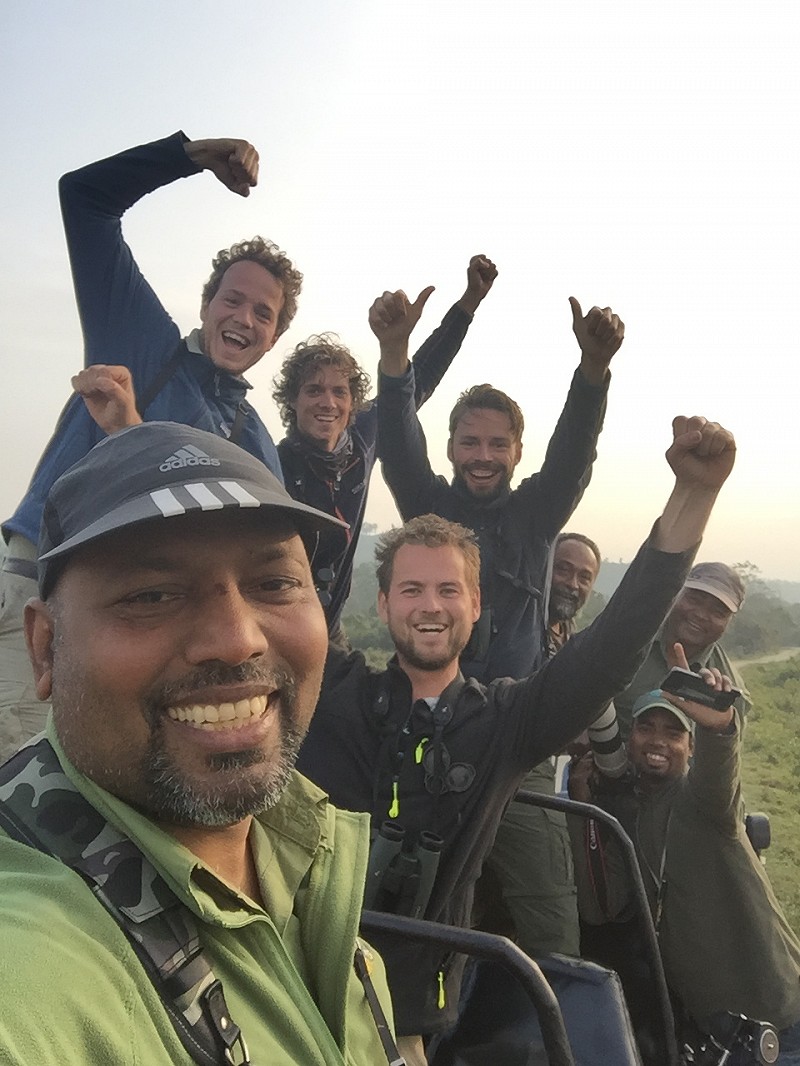Arjan's Biggest Year
In 2016 I will attempt the ultimate in global birding, to break the world record in birdwatching, this involves observing more than 6000 species in a single year!
Like my predecessor Noah Strycker I will count heard-only birds, but I will differentiate between heard-only- and seen species to make sure my list stays comparable.
During my 'Biggest Year' I will raise money for the groundbreaking Birdlife Preventing Extinctions Programme in a collaboration with Vogelbescherming Nederland and the Dutch Birding Association. This programme aims to prevent the extinction of all globally threatened bird species by applying an active, innovative and highly effective methodology.
Arjan's Biggest Year is supported by:
January 15-23
27 januari 2016 · Arjan Dwarshuis · 7588 × bekeken
January 15th ON TO MEET THE LEGEND
We woke up today in a very misty Delhi and even though it was only 6:30 AM there was already so much traffic on the roads that I wondered if we were breathing in mostly fog or predominantly smog. We were heading for our last birding site in northern India, Okhla Bird Sanctuary, but on the way we had to pick up our friend and travel companion for the next 15 days, Arnoud Postema.
After a happy rendezvous with Arnoud we arrived at the sanctuary 7 AM in time for 2 hours of birding before our flight to Guwahati. The birding was OK, but since we did very well the last couple of days only 5 new Biggest Year birds were added to the list. One of these however was a very good one, a vagrant Pallid Scops Owl that had been hanging around for a week or so now, definitely a bird I will not see anywhere else during this year's travels.
The flight to Guwahati was delayed half an hour so we knew we would miss our 100% chance for Greater Adjudant on the Guwahati rubbish tip, but I have high hopes that we will run into one near Kaziranga later during this trip. Upon arrival in Guwahati I was excited about finally meeting Peter Lobo in person. Peter is a legendary birder who has been running tours in the region for 20 years now and he will guide us personally for the next 14 days, along with another brilliant young birder Rofik Islam. I aim on leaving India on the 30th of January with 800 species under the belt and for that to happen I can only do this trip with the best.
January 16th EAGLENEST HERE WE COME!
The day started with a laugh when a rooster tricked us into believing it was a Spot-bellied Eagle Owl screeching, so around 3 AM Sander, Arnoud, Max and yours truly were standing half naked outside our tent in Nameri Camp listening for last night's dinner.
We slept for a couple of more hours and then it was game time, well it was raining cats and dogs so the start was a little rustier than we'd imagined. So as we crossed the Jia Bharaly River to get to Nameri NP, the haunt of the incredibly shy and endangered White-winged duck, rain was pouring down on us, but the hypothesis of bird activity being at its peak right after a downpour kept the spirits up.
And luckily for us the birding-gods were smiling down on us just as we set foot in White-winged Duck-country, the rain stopped and suddenly birds were everywhere. One feeding flock after another mend that Biggest Year ticks came thick-and-fast: Silver-breasted- and the clown-like Long-tailed Broadbill, the sometimes difficult Spot-winged Starling and the tricky-to-find Black-breasted Thrush. Our major target however was hopefully lurking somewhere on a small forested pond ahead of us. Slowly we approached pond, making sure we were not making a single sound and as we cleared another corner of the trail we saw an incredibly ugly, but incredibly rare duck sitting at the back of the pond. Yes! Target secured!
After this highlight we were back at Nameri Camp for another highlight, my interview with Dr. Deepak Apte, director of the Bombay Natural History Society and Chewang Bonpu and Nosang Limboo, members of the Sikkim Ornithological Society. During a very interesting hour they told me all I wanted to know about conservation and wildlife issues in India, which provided beautiful context to this incredible leg of my Biggest Year.
Next we drove off to my all-time dream destination, Eaglenest NP and after a 5 hour ride through the most beautiful landscape imaginable and clearing the militarized zone we arrived just after dusk at Lama Camp, the haunt of the critically endangered Bugung Liocichla.
January 17th LAMA CAMP
I zipped open my tent at 5:30 AM and gazed upon the first light of dawn over distant snow-covered Himalayan peaks, beside the TL-light produced by the radiator of Lama Camp there were just stars, what an incredible feeling of desolation.
After our morning chai we went in search of the enigmatic Bugun Liocichla, a critically endangered bird only discovered in 2004 and named after the native Bugun tribe. The bird is notoriously difficult to find and supposedly only 12 pairs are known. It prefers areas of thick secondary growth created by landslides and weirdly enough it is not found in any of the nearby valleys. Naturally we were keen on finding this enigma...
But today was one of those days. We waited and waited, checked every flock, heard two birds calling continuously from barely 40 meters away, but the birds would just not show. One for the Biggest Year list, but very frustrating not to see it to say the least. We will have one more shot at it on our way back from Bonpu Camp, I have good hopes...
Besides the Liocichla it was of course very good birding is these pristine setting. Plain-backed- and Dark-sided Thrush, a flock of Cutias, Grey-headed Bullfinch, several different laughing-thrushes, White-breasted- and the rare Brown Parrotbill and Golden-naped Finch. When darkness set in we drove off to an even more remote place, Bompu Camp.
January 18th BOMPU CAMP PART I
We had a slow start today, a long and cold wait inside a beautiful stretch of forest did neither materialize into the hoped for Ward's Trogon or Blyth's Tragopan, but we would have another chance at these mega's in the Mishmi Hills. This day turned out to be like a diesel engine, after the slow start we began to warm up with a pair of the elusive Crimson-browed Finch and not long thereafter one of the ultimate targets Fire-tailed Myzornis was secured; what a cracking bird!
We hit flock after flock and suddenly we had a fantastic pair of the rare Black-headed Shrike-babbler in a Coral-billed Scimitar-babbler party, things were going well! Meanwhile we were in awe of the stunning pristine forest all around us, Eaglenest is surely one of the most incredible and isolated places I've ever been and without a doubt we will be back someday.
After lunch we went downhill in search of Wren-babblers, but on the way down we hit a big flock and moments later we were looking at the highly sought after Beautiful Nuthatch, one of those Eaglenest must-see birds! We had barely set foot out of the car when a Long-billed Wren-babbler started calling and after a short playback of its call we were enjoying point-blank views of this mini-kiwi.
The Sikkim Wedge-billed Wren-babbler that we tried half an hour later proved far more elusive and despite hearing it fantastically for 15 minutes only Max managed reasonable views of this notorious skulker. On the way back to Bonpu Camp we had another great sighting when a Dark-sided thrush popped-up from the roadside vegetation. What a day! We set the alarm at 3:30 AM as we would drive all the way down to find the bamboo-specialists tomorrow...
January 19th BAFFLING BABBLER BONANZA
As we drove down into the night we had no idea of what kind of mega-day laid ahead of us, but things started of whit a bang when a Leopard Cat crossed the road in front of us. So it turned out to be a good decision after all to sit with all four of us tucked like a can of sardines on the back-seat of the front Jeep!
At daybreak we were in the bamboo and within minutes we found the hoped for mega-flock. White-hooded Babbler, Rufous-headed Parrotbill, Yellow-bellied Warbler, Rufous-faced Warbler, Red-billed Scimitar-babbler and Pale-headed Woodpecker, incredible!
And as we slowly walked down we kept the pace going, one lifer after another hit behind every bend in the road, but the definite highlight was the babbler-overload; we clocked out at a staggering 28 species! Most celebrated were Eye-browed Wren-babbler, White-hooded Babbler and Rufous-backed Sibia.
Besides the babblers the birding was simply phenomenal and Long-tailed Thrush, Slaty-bellied Tesia and many more species kept us busy till dusk when to top things off a Grey Peacock-pheasant crossed the road in front of the car... As you can image we had a well-deserved beer that night (despite dipping on Rufous-necked Hornbill... Arghhhh....)
January 20th WHEN THE GOING GETS TOUGH THE TOUGH GETS GOING
Yesterday we had a flaming start, but today was totally different, since 2 AM rain was pouring down and things hadn't changed when we had our 5 o'clock chai. At that moment we had no idea that things would be getting a whole lot worse, but that in the end these events would lead to an encounter that would stay in our memories forever, faith my friend, was in the making.
Let me tell you how this story unravels. When we drove up towards Eaglenest pass the rain gradually transformed into snow and before we knew it we were driving through a winter landscape. Peter told us that 26 years ago snow fell here for the last time. The jeep was struggling to stay on the road and from time to time we had to push with all four of us. We cleared a landslide with our bare hands and pushed through. We knew we had to clear the pass before nightfall or else we would be stuck for god knows how many days in Eaglenest (well, I guess there could be worse places for a birder to get stuck, but since I had to break a record I had to get out of there).
Peter and the four of us decided to undertake the 14 km walk through dense snow, across the pass towards Lama Camp, where Peter would have cell-phone reach to check on the situation at Sela pass; our next destination. Behind us the rest of the team were literally pushing the two vehicles up the mountain... Still 10 km from Lama Camp suddenly we heard the liberating sound of a jeep approaching and by some miracle the guys had managed to get the vehicles over the pass before the snow had frozen which would have turned the road into an icy slip-and-slide.
Peter made his phone calls and came back with bad news, a huge weather system had hit the Himalayas and higher up near Dirang and Sela almost a meter of snow made getting there, let alone birding there, impossible. No Monal, no Blood Pheasant, nor any other high altitude species. Than Peter calmly spoke: 'Don't worry, you are in the hands of Peter Lobo, I will make sure you will get to a fantastic birding site' and within minutes and making another 4 phone calls he had made a back-up plan. We would drive straight to Kaziranga - where we would arrive around 11:30 PM (thanks to the incredible driving skills of Peters' drivers) - and after two nights in Kaziranga we would go on to Nagaland, a remote birding area right at the border of Myanmar. When I decided to do a big year, this was what I signed-up for. Adventure!
January 21th A ONCE IN A LIFETIME SIGHTING
We ought to be birding at Sela Pass this morning, but instead we were now sitting in an open safari jeep heading for Kaziranga National Park to do a game drive. The pain of not being able to do any birding at Sela Pass was soon forgotten when we were parked in the middle of Kaziranga NP with the engine off, absolute silence, the warm sun on our faces and Indian Rhinos and Swamp Deer standing in the background. And then we had the first magical moment of the day; suddenly the air filled with large souring bird and before we knew it some of the worlds' most endangered birds were right overhead: 2 Greater Adjudants, 20 Lesser Adjudants, 200 Spot-billed Pelicans, 5 Black-necked Storks, 30 Slender-billed Vultures, a Red-headed Vulture, a male Pied Harrier and about 10 Grey-headed- and 3 Pallas's Fish-Eagles. We had no idea that this was just a warm up for the afternoon game drive...
Around 2 PM we were back in the park, of course hoping to see a tiger. Barely 5 minutes after we entered the gates we heard some alarm calls so we stopped at an open marshy clearing, shot the engine off and waited... Besides wild Buffalos and an Indian Rhinoceros with her calf there was a small herd of domestic cattle that had slipped under the radar o their owner and had wandered into the park, a bad decision...
After about half an hour still nothing had happened when suddenly Max spotted a movement in the bushes to the left of us. He had a very brief view of a huge striped back moving through the shadows and he whispered TIGER!! Moments later we watched the ultimate cat, the most majestic animal in the world and the icon of India slowly entering the arena, what a thrill, but while gasping at the huge male tiger we began to realize that it was heading straight for that herd of cattle. And then it happened, the tiger build up momentum and went into attack modes and went straight for the kill. Barely 40 meters away from us the tiger took down one of the cattle, but that wasn't enough. Apparently he had decided that the first kill wasn't big enough, so in a split second he was back on his feet and chased the herd again and took down another cow! Holy moly. And I put the whole thing on video, can you believe it?!
As you might understand we had one of the best beers of our lives that night and realized that if it hadn't snowed in Eaglenest for the first time in 26 years, we would have missed the greatest sighting ever!
 Happy guys after multiple sightings of Tiger at Kaziranga NP, Assam, India (Peter Lobo)
Happy guys after multiple sightings of Tiger at Kaziranga NP, Assam, India (Peter Lobo) January 22th QUALITY OVER QUANTITY
Today started with a bang! Just as I was brushing my teeth I heard a very loud screech, it took about two seconds, but then the penny dropped as Van Gaal would say, Spot-bellied Eagle Owl! Still in my underwear I sprinted outside where I stumbled across a bewildered half naked Sander who had also heard the owl. For the second time this trip we were half naked in the middle of the night outside our room, last time we were tricked by a rooster, but this time we had hit the jackpot! We aimed the torch at where the sound had come from and there sat a majestic Spot-bellied Eagle Owl, what a start of the day!
After our daily chai we went after another Holy Grail, the endangered Blue-naped Pitta. As I am a huge Pitta fan I was very keen on seeing this bird and since we had started off so well this morning I was quite feeling it. So we began to sort through gully after gully when suddenly a Pitta gave its diagnostic call. We positioned ourselves behind a bush, Rofik played the call and we waited... The trick to see a pitta is to sit absolutely still since these jewels-of-the-forest are incredibly shy and have notoriously good eyesight, Blue-naped Pitta is no exception to this rule... I picked up a movement to the right of me, exactly where the bird had called last, I aimed my binoculars at where I'd seen the movement and there sat the bird of the trip for me so far. What a cracking beast of a Pitta!
The rest of the day we were on the road towards the remote village of Khonoma in the state of Nagaland, barely 5 km from the border of Myanmar. In this region one can find some incredible birds that have a tiny distribution. Khonoma is the first village in this region that has broken with the deeply rooted tradition of hunting birds, instead they are now seeing the benefits of conservation as a catalyst for ecotourism in the region; a rare bird is far more valuable alive in its natural habitat than dead on a plate. We would stay for two nights in a homestay, the perfect example of how conservation can benefit both birds, birders and local communities.
January 23th THE HILLS OF NAGALAND
We spend the full morning roadside birding in the hills of Nagaland. Much of the habitat is rather degraded, but still some very good species can be found if you know exactly where to look; luckily we had Peter and Rofik.
We had already notched-up a couple of quality birds when we found several huge bee-hives hanging from a cliff-face above the road, perfect conditions for a Yellow-rumped Honeyguide we figured. And surely within minutes we found one of these rare eastern Himalayan endemics. I lingered around a little longer to get some digiscope pictures of this Asiatic relic of a predominantly African bird family when I found 2 more birds calling next to the hives!
Shortly after this success the most range-restricted endemics of them all called from uphill, the Naga Wren-babbler. Rofik urged us to follow him straight up the steep hillside and as soon as we entered the thick secondary growth where the bird had called from we played the tape. Immediately we got a response and moments thereafter we had incredible views of this skulker.
The rest of the day we went in search of Solitary- and Wood Snipes. We failed to find any Solitary Snipes in the grassy marshlands down the valley, but surely - after our 7th try - we flushed the much rarer rather Woodcock-like Wood Snipe, a very good sighting!
As evening fell we enjoyed the bizarre calls of a very nearby Black-tailed Crake that somehow managed to remain hidden from sight. With 21 new species Nagaland turned out to be a good substitute for the Sela pass. Tomorrow we will wake at 3:30 AM for the 10 hour drive to Tinsukhia.
Happy birding!
Discussie
Gebruikers van het forum gaan akkoord met de forumregels.





























.jpg)




